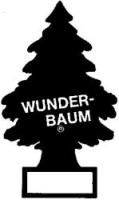CLASS 46
Now in its twelfth year, Class 46 is dedicated to European trade mark law and practice. This weblog is written by a team of enthusiasts who want to spread the word and share their thoughts with others.
Want to receive Class 46 by email?
Click here subscribe for free.
Click here subscribe for free.
Who we all are...
FRIDAY, 5 OCTOBER 2012
Poland: the abuse of trade mark rights
 This is the continuation of the story described in "Poland: Wunderbaum is the reputed trade mark". The Polish company S&S Smiczek & Smiczek Hanna Smiczek brought a cassation complaint.
This is the continuation of the story described in "Poland: Wunderbaum is the reputed trade mark". The Polish company S&S Smiczek & Smiczek Hanna Smiczek brought a cassation complaint.
The Supreme Administrative Court in its judgment of 10 July 2012 case file II GSK 2324/11 repealed the contested judgment and returned it to the VAC for further reconsideration. The Court held that the important drawback of the contested judgment and the decision of the PPO was the assumption on the similarity of the opposed trade marks that was based on the mere fact of the use in their visual aspect, a form of tree, without trying to examine whether the different presentation, including the type and shape of the tree, used in these signs, allowed for the adoption of the view that there exists the similarity of the signs. As a result, the Polish Patent Office, followed by the VAC, accepted the monopoly (exclusiveness) of the company to use very idea of the tree element in its trade mark. The SAC recommended that the VAC should also take a stand on the consequences of the fact that S&S Smiczek & Smiczek Hanna Smiczek used its trade mark for a considerable period of time from 2002. After almost 5 years, Julius Sämann Ltd. initiated a civil action against the S&A. The civil proceedings with regard to trade mark infringement ended before the Supreme Court in its judgment of 14 October 2009 case file V CSK 102/09. The Supreme Court dismissing a cassation appeal filed by Julius Sämann Ltd., based on the argument that long-standing and undisturbed use of the sign in question, in connection with the principle venire contra factum proprium, according to which, if the party continued at a specific practice, it can not rely on its illegality, if other entity accepted such practice in good faith and it could suffer injury as a result of the changes. The application of this rule would come into play especially in a situation, if after the reexamination of evidence, the similarity of opposed signs has been established, and there was not any proof of bad faith on S&S side. The argument that there was bad faith requires evidence and proof, because good faith is presumed.
 Whether, in connection with long-term use, the S&S trade mark has acquired distinctiveness under average conditions of the market, a feature which is required for any sign to be registered, could speak in favor of the principle of venire contra factum proprium. In addition, marking the goods produced by S&S with its own trade mark, which are the goods of the same kind as products of Julius Sämann Ltd., undoubtedly positively affected the overall demand for such goods on the marker. Therefore, the invalidation of S&S trade mark in situation of its use in good faith, could easily lead to the acquisition of the customers of S&S by Julius Sämann Ltd., without incurring the costs which were attended by S&S in the promotion of the sign. The Court found it difficult to accept. The SAC also held that it should be borne in mind that the right of protection for a trade mark, as every object in the closed list (numerus clasus) of property rights, is admittedly an absolute personal right effective against all (erga omnes), however, this right is not subject to absolute protection. In the light of the general principles for the exercise of property rights as defined in the Polish Civil Code, the boundaries of this right are defined in the Acts and the rules of social coexistence. The Polish Industrial Property Law also refers to these rules. For these reasons, the circumstances giving rise to the allegation of the infringement of the principle of venire contra factum proprium, are one of the limits to the exercise by the owner of its legitimate socio-economic use of the right of protection that derives from the registration of the trade mark. Thus, the invalidation proceedings that were started against the trade mark Forest Fresh R-183901, in violation of the above mentioned principle, may be considered as the abuse of the right of protection for a trade mark by the proprietor of such a right, that is not entitled to the protection.
Posted by: Tomasz Rychlicki @ 17.08
Whether, in connection with long-term use, the S&S trade mark has acquired distinctiveness under average conditions of the market, a feature which is required for any sign to be registered, could speak in favor of the principle of venire contra factum proprium. In addition, marking the goods produced by S&S with its own trade mark, which are the goods of the same kind as products of Julius Sämann Ltd., undoubtedly positively affected the overall demand for such goods on the marker. Therefore, the invalidation of S&S trade mark in situation of its use in good faith, could easily lead to the acquisition of the customers of S&S by Julius Sämann Ltd., without incurring the costs which were attended by S&S in the promotion of the sign. The Court found it difficult to accept. The SAC also held that it should be borne in mind that the right of protection for a trade mark, as every object in the closed list (numerus clasus) of property rights, is admittedly an absolute personal right effective against all (erga omnes), however, this right is not subject to absolute protection. In the light of the general principles for the exercise of property rights as defined in the Polish Civil Code, the boundaries of this right are defined in the Acts and the rules of social coexistence. The Polish Industrial Property Law also refers to these rules. For these reasons, the circumstances giving rise to the allegation of the infringement of the principle of venire contra factum proprium, are one of the limits to the exercise by the owner of its legitimate socio-economic use of the right of protection that derives from the registration of the trade mark. Thus, the invalidation proceedings that were started against the trade mark Forest Fresh R-183901, in violation of the above mentioned principle, may be considered as the abuse of the right of protection for a trade mark by the proprietor of such a right, that is not entitled to the protection.
Posted by: Tomasz Rychlicki @ 17.08
Tags: Poland, famous trade marks, abuse of rights, likelihood of confusion, non-traditional trade marks,


 Sharing on Social Media? Use the link below...
Sharing on Social Media? Use the link below...
Perm-A-Link: https://www.marques.org/blogs/class46?XID=BHA2995
Poland: the abuse of trade mark rights
The Supreme Administrative Court in its judgment of 10 July 2012 case file II GSK 2324/11 repealed the contested judgment and returned it to the VAC for further reconsideration. The Court held that the important drawback of the contested judgment and the decision of the PPO was the assumption on the similarity of the opposed trade marks that was based on the mere fact of the use in their visual aspect, a form of tree, without trying to examine whether the different presentation, including the type and shape of the tree, used in these signs, allowed for the adoption of the view that there exists the similarity of the signs. As a result, the Polish Patent Office, followed by the VAC, accepted the monopoly (exclusiveness) of the company to use very idea of the tree element in its trade mark. The SAC recommended that the VAC should also take a stand on the consequences of the fact that S&S Smiczek & Smiczek Hanna Smiczek used its trade mark for a considerable period of time from 2002. After almost 5 years, Julius Sämann Ltd. initiated a civil action against the S&A. The civil proceedings with regard to trade mark infringement ended before the Supreme Court in its judgment of 14 October 2009 case file V CSK 102/09. The Supreme Court dismissing a cassation appeal filed by Julius Sämann Ltd., based on the argument that long-standing and undisturbed use of the sign in question, in connection with the principle venire contra factum proprium, according to which, if the party continued at a specific practice, it can not rely on its illegality, if other entity accepted such practice in good faith and it could suffer injury as a result of the changes. The application of this rule would come into play especially in a situation, if after the reexamination of evidence, the similarity of opposed signs has been established, and there was not any proof of bad faith on S&S side. The argument that there was bad faith requires evidence and proof, because good faith is presumed.
Tags: Poland, famous trade marks, abuse of rights, likelihood of confusion, non-traditional trade marks,


 Sharing on Social Media? Use the link below...
Sharing on Social Media? Use the link below...Perm-A-Link: https://www.marques.org/blogs/class46?XID=BHA2995
Reader Comments: 0
Post a Comment
MARQUES does not guarantee the accuracy of the information in this blog. The views are those of the individual contributors and do not necessarily reflect those of MARQUES. Seek professional advice before action on any information included here.
The Class 46 Archive

